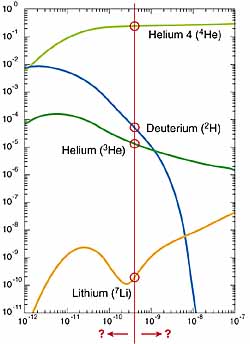
Matthew Chalmers has a story in New Scientist (07 July 2008), "Lithium: The hole in the big bang theory", which addresses the problem the early forged light element lithium may present for the Big Bang theory (paywall). In this 2007 PhysicsWorld article, "Testing the elements of the Big Bang", Kenneth Nollett explains that most of the elements with which we are familiar (oxygen, calcium, carbon) were forged inside stars long after the Big Bang. However,
The nucleosynthesis, in which the other light elements, including lithium and helium, originated, is thought to have lasted only a few minutes. So why a problem?
(Note: The chart is from NASA's "Universe 101.")
One big exception is hydrogen: almost all hydrogen nuclei are protons that emerged from the Big Bang almost 14 billion years ago. Another is light nuclei such as deuterium and lithium, which were produced in a process called Big Bang nucleosynthesis that occurred when the universe was only a few minutes old.
The nucleosynthesis, in which the other light elements, including lithium and helium, originated, is thought to have lasted only a few minutes. So why a problem?
Recent measurements of the cosmic background radiation, which reveals the universe as it was when atoms formed about 380,000 years after the Big Bang, and of the large-scale distribution of galaxies have greatly increased the precision of cosmological data. So far it seems that the observed primordial abundances – particularly those of lithium – do not quite tally with BBN theory. The goal now is to bring BBN into line with the new precision of cosmology, and to improve our understanding of the astrophysical environments where the primordial abundances are observed.Basically,
BBN predicts that there are 4.7 × 10–10 lithium-7 atoms for every hydrogen atom, while the Spite-plateau stars contain only about 1.4 × 10–10. Several explanations for this discrepancy have been proposed, but no-one knows the right answer. Either some important physical process is missing from BBN theory, some astrophysical mechanism destroys large amounts of lithium-7 after BBN, or there is something is wrong with our interpretation of stellar spectra.Lithium, of course, is much better known to the public than its rarity would suggest because of its fabled role in the treatment of mental illness.
(Note: The chart is from NASA's "Universe 101.")

